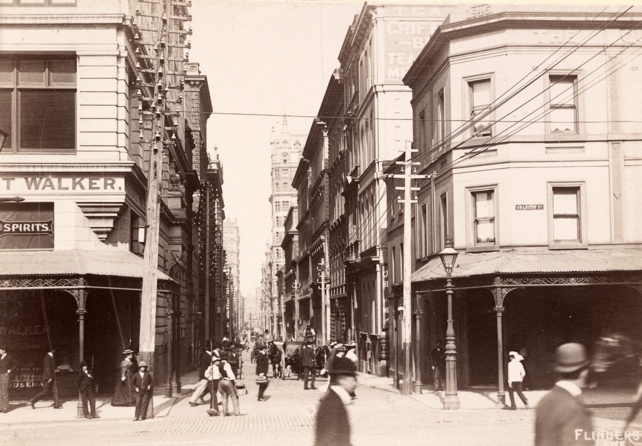Resource Sheet 1
Select account of Melbourne
Melbourne
Melbourne, to which George Augustus Sala, when in this country, applied the prefix of ‘marvellous’, which has stuck, is one of the most regularly-laid-out cities in the world. In this it differs widely from Sydney which was practically laid out by bullock-drivers, when they made their tracks through the scrub. The original plan of Melbourne provided for wide streets, each a mile long and a chain and a half wide, running parallel with the Yarra River, at intervals of an eighth of a mile; but when Governor Bourke saw the plans which his surveyors had drawn up, he considered that the blocks so formed were too large, and so a compromise was effected by running lanes between all the transverse streets, with the object of giving access to the back yards.
It is needless to say that, as the city grew, these were diverted from their original purposes, and became streets themselves. Little Flinders Street, now generally known as ‘The Lane’, is a street of great warehouses, in which is done the chief wholesale business of the city, especially in soft goods. In a cottage of two rooms, in this lane, was opened the first bank in Victoria, the little branch of the Bank of Australasia…
Collins Street… is one of the finest thoroughfares in the world… At one end of Collins Street are the residences of leading doctors, forming quite a medical quarter. In the street are the finest shops in Melbourne, and here are splendid newspaper offices, banks, insurance offices, and great places of general business as well as churches and palatial hotels…
Melbourne, like other of the great Australian cities, is happy in the possession of some very fine parks and public gardens, which are highly appreciated by residents and visitors. One of the finest is the Fitzroy Gardens, which occupy high ground in the very centre of population, and beside the handsome Treasury Gardens, and a number of splendid churches and public buildings. The transformation which has been effected in the site of these gardens would amaze any old resident of Melbourne, could he return after a long absence.
ED Hoben, Glimpses of Australia. An Album of Photographic Gems. Volume II, Gordon and Gotch, Melbourne, 1897.
Flinders Lane, looking west from Swanston Street, Melbourne, 1895

State Library of Victoria, H82.246/3.
Collins Street near Queen Street, Melbourne, c1895

F Boileau, National Library of Australia, nla.pic-an3366506-s15-a1.
Select accounts of Bendigo, Echuca and Portland
Bendigo
Bendigo, is a very fine city, famous in the goldfield annals of Victoria. Originally, like all of these fields, the rush was caused by alluvial discoveries, but as the fields developed, it became almost wholly quartz-reefing… The city is particularly well built, and presents some very fine examples of architecture and city views. One of the finest is Pall Mall and the buildings around that handsome centre, and it is here that the imposing fountain… is situated. The Pall Mall is the main street. On one side of it is umbrageous reserve known as Rosalind Park, with its leafy avenues and smooth swards. On the other are great buildings of brick and stone, including the splendid Government Offices and Law Courts.
ED Hoben, Glimpses of Australia. An Album of Photographic Gems. Volume II, Gordon and Gotch, Melbourne, 1897.
Echuca
Echuca is an important town on a peninsula formed by the Murray and Campaspe rivers, some 156 miles north of Melbourne. Originally it was a great stock crossing place between New South Wales and Victoria… In the present day it is an important town, a centre of railway communication and trade, with two newspapers, and all the appurtenances of urban existence. It is the centre of trade along the river, which is carried on by the big barges… and by river steamers. Some of the river steamers are themselves perambulating stores, in which their owners go round to their customers and whistle for them to come down to the banks and step into the floating shop to buy, and the fair sex in the remoter Murray district take just as keen a pleasure in their shopping thus as their sisters of Sydney or Melbourne.
ED Hoben, Glimpses of Australia. An Album of Photographic Gems. Volume II, Gordon and Gotch, Melbourne, 1897.
Portland
The most fertile and prosperous of the country parts of Victoria is the rich agricultural western district… It is highly favoured in all its natural conditions, both as regards soil and climate… The so-called Bay of Portland scarcely deserves the name of a harbour, but is rather an open roadstead, greatly exposed to stress of weather… The houses of the town are built chiefly of dark blue-stone, which presents a solid but mournful appearance, except when a bright glow of sunshine is shed over the blue waters of the bay, lighting up the land and sea alike with its cheering rays.
‘A Resident’, Glimpses of Life in Victoria, introduced by Marguerite Hancock, Melbourne University Press, Carlton South, 1876.